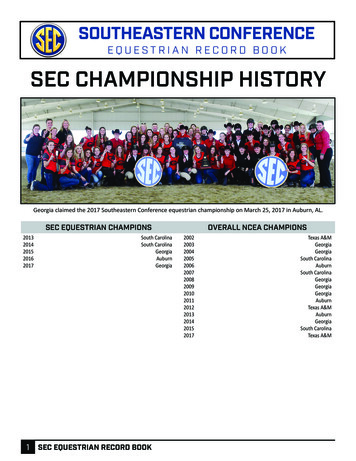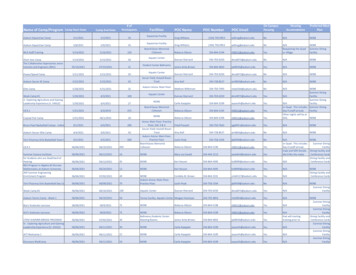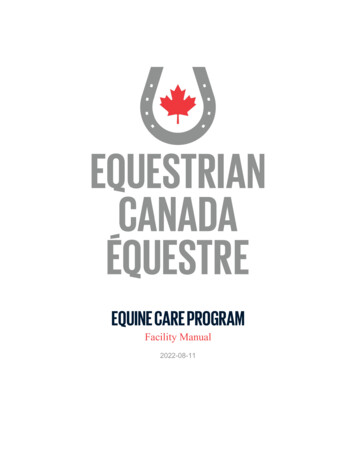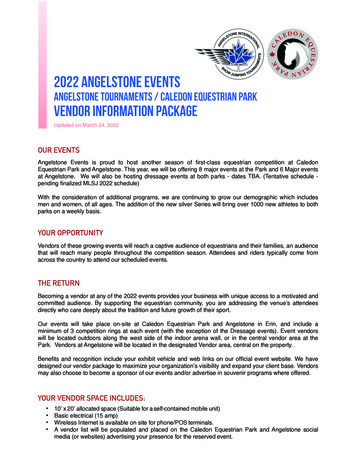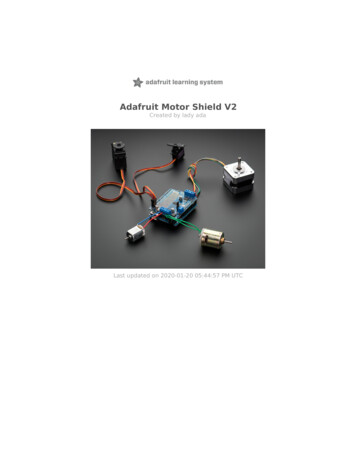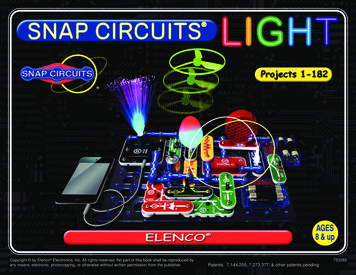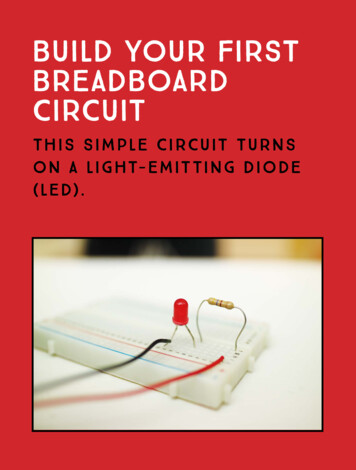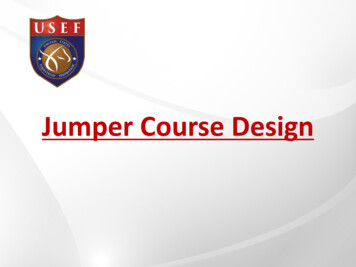
Transcription
Jumper Course Design
Course Designers have aResponsibility Toward: HorsesRidersShowsSpectatorsSponsors The Sport, as a whole.
Good Course Designers Are good horsemen with extensive knowledge andbackground in the sport. Take the responsibilities of the job seriously. Have an ability to organize, set priorities, andmanage details. Use tact and skill in working with show officials andtheir helpers and crew. Are flexible enough to cope with anything that mightcome up.
Course Designers must alwaysconsider: Safety, first and last. Producing fair and fun sport. Promoting horsemanship by always rewardinggood training and riding. Presenting the sport in a beautiful and naturalway. Directing the future of the sport.
A Course is only as Good as it isSuitable!Every course must suit: The level of the event.The purpose of that particular class.The size of the arena.The weather conditions and the footing.The day’s time schedule.
Young Horse Classes This is where future open horses start out be sure to givethem a chance for long and successful careers. Remember 5 year olds are Jumping’s equivalent of BabyGreen Hunters; keep the courses INVITING. Table II and Table IV classes are meant to produce clearrounds, do not make them overly difficult. Measure the course generously; keep the beginning of thecourse and all combinations and lines simple for 5 year olds.Gradually educate 6 and 7 year olds. Be aware of all the specific rules for YJC classes.
Children, Adult Amateurs & Ponies These riders have little experience (and/or skill), butoften their horses are “over-qualified”. Some riders, though not all, are planning to move upand are looking for preparation. Always avoid rewarding “reckless speed”; emphasizeturns! Never use two stride combinations when speed counts. Always avoid long runs to jumps, especially at the endof the course or the jump-off!
Experienced Horses Consider what will be the final/most important classof the show and build toward it. Always avoidstarting too strong Challenge, but do not overwhelm or over-tire. Consider how many total efforts are being asked in II2(b) classes. Keep your combination(s) from being the mainsource of difficulty in the course.
What is a course?Height
Good Courses Are Tests Of:1. The TRAINING LEVEL of the horse and the rider.2. The COMMUNICATION and CO-OPERATION between the horseand rider.3. The horse’s degree of BOLDNESS, CAREFULNESS, andCONCENTRATION.4. The JUDGMENT and CONCENTRATION of the rider.5. The adjustability of the horse’s STRIDE and BALANCE.6. And lastly, SCOPE.
Elements of a Course The “track”. Types and locations of jumps. Especially the position ofcombinations and “related lines”. Jump construction. (Solid, airy, top cups & poles). Distances between jumps. Height and width of the jumps. Speed and measurement for the time allowed. Footing, light, the in-gate, and all of the othercomponent factors.
Parameters of a Good CourseForward track, suitable to the type of competition.Balance between spreads and uprights.Good proportion between left and right turns.Variety in the types of combinations used.Changes on the lead of approach to combinations.Avoid repetition of related lines (short, long, 3-4-5-6strides, oxer-vertical, vertical-oxer). Noticeable differences of fence construction. Difficulty compatible with the level of competitors.
Difficulty FactorsObvious: The height of the jumps.The width of the jumps.The distances between the jumps.The time allowed.
Difficulty FactorsLess Obvious: The trackThe types of combinations and linesThe approachesThe distractionsThe construction of the jumps
Difficulty FactorsSubtle: The fence materialThe colors and the backgroundThe decorationsThe length and the number of effortsThe balance and flow of the course
Relative Degrees of Difficulty
Difficulty FactorsCombinations: Use variety Do not compound the questions Save distance problems for specialcircumstances Watch the number of spreads Be careful with the approaches
Jump-OffsConsiderations: How many jumps? Balance of left and rightturns Inside turns. Combinations “Handy vs. Galloping” Changing the jumpdimensions / direction Verticals and Oxers Turns with Oxers Triple Bars Swedish Oxers
Think about the Consequences! How likely is a mistake? What will be the result of a mistake? Can you make the price of an error moreeducational and less of a punishment,especially for the horse?
What makes a Great Result? Every competitor has a chance to finish the course. No bad crashes. Every competitor up to the standard and without anerror can produce a clear round. Weaknesses in training or riding mistakes produce thefaults, not traps in the course. Faults are “educational” and not “punishing”. Many competitors have only one fault, and the faults arespread evenly around the course.
And a good Jump Off ? Viewable and exciting for the audienceUse of the entire fieldBalance of left and right turnsTurns before and after jumpsPlaces to gallop and make up time“Inside/outside” optionsLuck of the draw
StatisticsEvaluating your Jumper Course: Watch every horse go.Keep track of fences that come down.Look for “balanced” results.Note unexpected trouble spots.
Arriving at the Show Meet the Organizers/Manager Check for any schedule changes and updateyour time schedule Look at the arena(s) and check their size,footing, lighting and any irregularities Meet with your assistants/crew See if a tractor and trailer are available Locate and try out the copy machine
Getting to Work Make a detailed inventory of the material youhave to work with Finalize your first day’s plans and make copiesfor the crew Build the course Confirm when everyone will arrive the nextday (It is better to work the night before) Leave a set of the day’s plans with the TC topost
What needs to be on a Course Plan? Class Name and Number Start & Finish lines Fences numbered and with arrows to showdirection, compulsory turning points, etc. Table, Speed, Length of Course, Time Allowed, TimeLimit, Jump-Off information Indicate: Option Jumps, Closed Combinations Helpful items: Day, Date, In/Out gate, Show Name,Class type/height
Useful Tips Get a track first then add combinations, fencesand distances. Do not forget if a fence is part of the jump-off,becomes #1 or part of a combination or moves forlater classes. This can affect the material youchoose. Learn how to make simple and easy changes tothe course that will make different and moresuitable courses for later classes. This takespractice and thought.
Course Plan CopiesHow many? Keep a copy of your “Master”. Make enough “Clean Copies” of the plan for the judges,the in-gate, and the press or office, if requested. Keepone extra just in case! Prepare plans showing the adjustments and dimensionsfor each course change during the day; copy these forassistants and crew. Avoid making more copies than you need!
Building a CourseFrom an empty ring to ready for the first horse
“Lay Out” the Rails From your build sheet get the rails needed: 1 for each element of every jump to be built Position each rail on the ground; walking thedistances to get things close Look at the track as a whole! Now is the time to make any needed changesto the course!
“Frame” the Jumps Measure distances and spreads as you go Cross measure the lines and combinations sothey are straight Put your chosen wings on the ends of the laidout poles Put up the top poles (at the correct height) oneach jump Keep the wings straight.
Step One of Getting Lines Straight:
Step Two:
And, finally
“Fill” & Decorate Add the correct walls, gates, ladders and fillfor each fence Determine spacing of elements Add flower boxes, take-offs, etc. Add plants or shrubs to sides of jumps Check the flags and numbers Position the start and finish markers
“Finish” the Course Walk the whole course (including the jump-off) to seeall the details Check for proper cups, and extra material Check for tight poles Use the straightest and lightest poles for the top of eachjump, and re-check the heights, spreads and distances Measure jumper (and some equitation) courses tocalculate the time allowed Cross off (or remove flags) from unused jumps
“Start and Finish”Things to Keep in Mind: How the timer eyes workMoving them between classesMoving them for the jump-offWidth of Start and Finish linesHow far away from the jumpsStraight or angled?Positioning the flags
“Wheeling” the Course You must follow the natural line of the track, i.e., theline that links one jump to another There is only one track for each course You can adjust the time, not the track Pay attention to the speed of the class Be careful of overly tight turns Do not be too generous with jump-off times Always watch the first riders in the class Decide with the Judge, if the T.A. is good
Building for the Second DayUse the same basic technique, except: Work around the “old” jumps Move only the “lay out” poles first Keep extra material in the ring whenever youmay need it later by using “dummy” jumps,islands or “winging” material to the side Take extra material out last of all
The Building Process Simplified Lay out poles in the correct locations. (This isthe MOST important thing to get right!) Frame each jump, being sure all distances aremeasured correctly Fill each jump Decorate, flag and number the jumps Measure the track Check, double check and re-check
DISTANCESPractical application
Tests, Problems and Related DistancesIn setting tests for horses and riders, it isnecessary to study: Distances between fences, both in and out ofcombination Factors that affect length of stride andimpulsion How the Course Builder must understand theinstinctive reaction that a horse will produceunder a given set of circumstances
What “Distance Questions” test: The rider’s eye The horse’s response to the aids Harmony between rider and horse The horse’s scope
Distances Between Similar FencesUpright to UprightSpread to Spread
However If you apply this principal to fences that are less than3 strides apart, you will come up with a distance thatmay be too short. Why? Because the horse and rider, upon seeing fences veryclose together, increase their forward movement(impulsion) so as to have enough energy to jump thesecond and third parts of the combination. Therefore, you must take this into account whenchoosing a distance.
Similar Combinations
Fences that are Not Alike The distance from spread to upright should be longerthan standard, and the distance from upright tospread shorter. Why? Because the take-off distance for verticals is furtherback than for oxers, which is further back than fortriple bars. Water jumps have the shortest take-offdistance of all. Landing distance for verticals is longer than for oxersand triple bars. Water jumps have a very shortlanding distance.
Jumping Arcs
Jumping Arcs
Examples:Spread to UprightUpright to Spread
FEI Suggested Jumping Distances
Remember Distances are influenced by:Type of fence Oxer Vertical Triple Bar WaterSlope Uphill DownhillFooting Sand or Grass Soft or Hard Slippery or “Cupping”Direction Toward In-Gate Away from In-Gate And, what comes before
Feet to Metres Conversion TableThanks to Richard Leslie Jeffery
Scoring TablesAnd their relevance to design
Table II Sec. 1 / Sec. 2 (a) Table II Sec.1 is NOT a speed class! It shouldbe built the same as any other Table II course,NOT like a Table III course. Table II Sec.2 (a) gives you the opportunity toadjust the jumps for the jump-off; and doesnot make the horses run over 6 to 8 morejumps only 45 sec. after completing the firstround.
Table II Sec. 2 (b) Pay attention if horses will be doing multiple classesin a day. Remember how much jumping is required in a shorttime; keep the first round shorter than in a II 2 (a)class. Since you cannot raise anything for the jump-off,always try to include 2 extra jumps – at jump-offheight.
Table II Sec. 2 (c) As we use this table, it is NOT “Power and Speed”, butis actually a “Two Phase” competition: a shortenedfirst round phase, with a jump-off second phase. Use a combination in each phase, but beware ofhaving a combination too early in Phase 1, especiallyfor inexperienced horses. Eight to ten efforts for the first phase and five toseven in the second is the rule – avoid having toomany jumps.
Table III This IS a speed class. It is not permitted for YoungHorses. In general, avoid square oxers, short combinationsand other Table II questions. These are the best classes to use permanentobstacles such as banks, grobs, dry ditches, etc. There is no longer a time allowed; only a time limit.
Table IV This is an optimum time class, optimum time beingdefined as four seconds less than the allotted timeallowed. Basically a schooling class, it should be built like aTable II course. As it is used here, wheel it normally and subtract fourseconds for the optimum time. Do not worry too much about the time allowed; itwill be all over the place.
Special Classes Read your rule book for the specifications of theseclasses – every time! Gamblers Choice/Top Score: keep material light forspreads; difficulty (including height) should vary withthe value of each jump; consider the position of thestart/finish line.
MiscellaneousAn assortment of good things toknow
Water Obstacles A water obstacle is a jump which requires ahorse to jump over water. A water obstaclemay be used as an open water jump, a railover a water jump or as a liverpool.
Liverpoolsa) Definition: A Liverpool is an obstacle built with water. Thewater may be used under, in front of or behind an obstacle(vertical or oxer). When used in this manner, the total widthof the obstacle (including the water), may not exceed 2m. Avertical jump may be built over the center of a 3m or lesswater (up to a 3.60m water in 1.60m classes only). The railsmay not exceed 1.50m in height and must be placed in safetycups.b) Scoring: In all cases only the rail is scored.
Water Jumps- MINIMUM 4.90 m (16’) WIDE FRONT- NOT TOO DEEP (see JP126 for details)- COVERED WITH RUBBER MAT- TAKE OFF BOX NO HIGHER THAN 76 cm (2’6”)- WHITE LATH OR PLASTICINE (OVER 50,000) ON LANDING SIDE- SHOULD BE PRESENT FOR A GRAND PRIX
Rail Over Water Jump A water obstacle may have one rail no higher than1.00m (3’3”) over it. The rail must never be placedbehind the center point and approximately 1/3 fromthe front is preferable. When the obstacle is built inthis manner, extreme care must be taken not tocreate an optical illusion to the horse with a large gapbetween the take-off element and the rail, or of thelath and the rail appearing to produce a false groundline.
NaturalObstaclesNormandy BankDry DitchesDevil’s Dike /Grob
Option Fences Use sparingly and for a specific reason. An option for lower level jumpers can be a usefultraining aid. However, in higher level classes, the option fenceis often used as a way encourage entries byallowing riders to avoid the desired test. Options in Table III classes, on the other hand,may make the class more interesting due to therisk / reward factor.
Safety Cups Are required on ALL rails of a vertical builtover a water jump. ONLY for back poles of spreads (including themiddle poles of triple bars.) FEI approved cups are essential because theycome with official certification to releaseconsistently at 140 Kg (308 lbs.) of pressure. A list of FEI approved cups is available via theUSEF or FEI website.
DIFFERENT TYPES OF CUPS
Safety IssuesExtra heavy equipmentJammed polesExtra poles and cups.Too deep cupsUse of natural obstacles, (banks,grobs, dry ditches, etc.) Use of water obstacles
Picture byAnthonyD’AmbrosioThe End!The USEF extends its thanks and gratitude to Linda Allen, Guilherme Jorge, Leopoldo Palacios, Richard Jefferyand Jack C. Robson, without whose contributions this presentation would not have been possible.
Fences that are Not Alike The distance from spread to upright should be longer than standard, and the distance from upright to spread shorter. Why? Because the take-off distance for verticals is further back than for oxers, which is further back than for triple bars. Water jumps have the shortest take-off distance of all.
